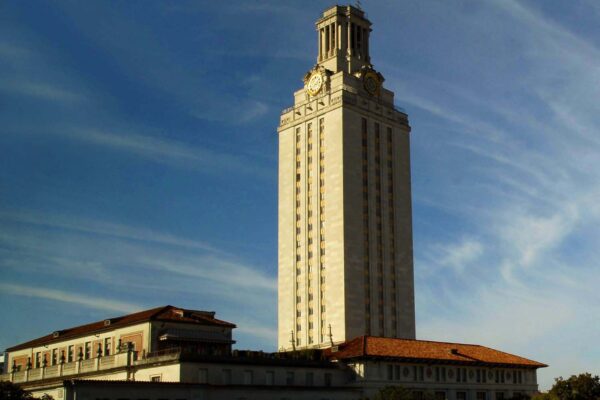The University of Texas at Austin’s strategic plan for the next 10 years was born out of a basic recognition that the world around us has changed radically — and that UT must define how it will embrace those changes to become the highest-impact public research university in the world. Staff and faculty members who have been at UT for the past five, 10 or 20-plus years know that the state of Texas, city of Austin and Forty Acres are different places today than when they came to campus.
Texas has the ninth-largest economy in the world and draws new residents and companies daily. Austin is the fastest-growing major city in the nation and is a hub for music, high tech and health care. And UT has climbed to become the 38th best university in the nation with 49 Top 10 programs, according to U.S. News & World Report. On top of that, COVID-19 drastically changed how we learn, work and interact. Staff and faculty members responded to those disruptions by innovating and adapting every aspect of campus life.

Against that backdrop, UT leaders understood that it was time to draw the first road map for the future since the university implemented the findings of the Commission of 125 in 2004. “The kind of things right now that are outside our front porch are much different than when we all got here,” said UT President Jay Hartzell, who first came to UT as a graduate student in business in 1993 and spent of most the next 30 years as a faculty member, dean and president.
“All of that is something that opens up a whole new set of opportunities to us,” he said. “The campus and university are at a moment in time that is special. We need to get the very best ideas on the table from a bunch of really smart people to take advantage of this we have in front of us today.”
Hartzell and the university’s leadership team began those conversations in early 2020 with hundreds of staff members, faculty members, students, alumni and external partners. They set out to fully understand UT’s current impact across dozens of disciplines, operations and partnerships — as well as the challenges it faces and the goals that employees and other community members have for the next decade and beyond.
The result is the aspiration to become the world’s highest-impact public research university. That aspiration will be built on five pillars that embody UT’s strengths: People, Place and the three Pursuits of Experiences, Education and Research.
While the full plan is still being finalized, some themes are already clear:
- The university will grow and serve more students, cover more of their financial need and pursue aggressive goals on diversity, equity and inclusion.
- UT will remain a residential university with a vibrant campus and redefine how to partner with all community sectors, including playing a critical role in health care.
- The university will create exceptional experiences for students, staff, faculty and alumni through a shared Longhorns culture, small communities and signature experiences that make a large university feel more intimate and through high-quality services and operations.
- As Texas’ flagship university, UT will drive educational reform to prepare students for the future, including a strategic expansion of continuing and professional education (CPE) programs.
- UT will become even more renowned as a research leader in three broad areas: energy and the environment, technology and society, and health and well-being.
“The sheer scale, breadth and depth of our university is different. Many universities are known for a few things. We are really good at a lot of things,” Hartzell explained in a podcast conversation with the three chairs of the strategic planning team: Natural Sciences professor Lauren Ancel Meyers, Law School professor and Associate Dean Bobby Chesney, and Liberal Arts professor and deputy to the president Richard Flores.
“Our talent is spread across campus in so many pockets of excellence,” he said. “All these things we bring together are done in a big way. We can have a different impact on the world around us than other universities can.” UT’s 24,000 staff and faculty are central to that impact, he said.
The strategic plan recognizes that staff work daily to make the Forty Acres a vibrant campus and support exceptional experiences; that faculty members drive teaching and research; and that they collectively improve the student experience so graduates are prepared to succeed once they leave campus. The plan also recognizes the need to retain talented employees and attract new ones.
It specifically calls for investments and initiatives to make UT a top workplace and to support career development. Those initiatives start at the ground level by upgrading information technology (IT) and streamlining purchasing and other systems to improve efficiency and employees’ daily workflow.
And they move on to a higher level. For staff, that includes improving workspaces, providing more resources and prioritizing pay, benefits and housing options while recognizing the high cost of living in Austin. It also means continually honoring staff accomplishments, including their tireless work serving the community during the pandemic.
For faculty, the strategic plan calls for creating a “value proposition” that makes UT the most attractive place to teach and conduct research. That includes supporting sabbaticals, increasing investment in community and peer clusters, and making faculty resources, pay, benefits and housing higher priorities when recruiting and retaining faculty members.
The complete strategic plan will be released this spring with dozens of specific initiatives and goals and will continually be refined with input from the UT community. Staff and faculty can offer ideas at the website, strategicplan.utexas.edu.
Hartzell said he has been struck during the yearlong process by UT employees’ passion for the Forty Acres and for the Longhorn experience, even as the campus, city and state have changed so much.
“I’m excited by the sense of mutual enthusiasm and love for the university, our mission and what we do — that sense of collective enthusiasm over how can we really change the world more effectively, more often and with more impact,” Hartzell said. “The chance to take advantage of the new Austin and the new Texas — that’s really exciting.”
Gary Susswein is the former UT chief communications officer and current consultant at New West Communications.




